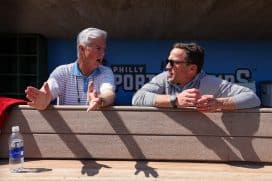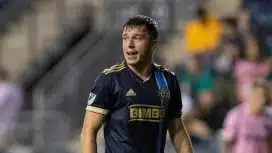Eagles
Divisional Round Evaluations: Front Seven
By Paul Bowman, Sports Talk Philly Editor
Leading up to the Eagles matchup with the New Orleans Saints on Sunday, Sports Talk Philly and Eagledelphia will compare the personnel of the two teams each day until gameday is here.
In this edition of our week-long comparison, we will look at the front seven that the Saints and Eagles will field on Sunday.
New Orleans DL/LBs | Cameron Jordan, Sheldon Rankins, Tyeler Davison, Alex Okafor, Marcus Davenport, David Onyemata, Demario Davis, Alex Anzalone, A.J. Klein
Cameron Jordan is the most lethal player of any player in the Saints front seven. He was selected to the Pro Bowl for the fourth time this season as well as to the AP’s second All-Pro team. Last season, Jordan made the first team. He has littered the NFL’s top 100 ranking on and off, appearing on the list in 2014, 2016 and again this past offseason. His results show that he is a very good player, but that he does not perform consistently enough to be considered truly elite. That said, this year has not been a down year for him by any stretch. While he has just 49 tackles and 21 quarterback hits, it is his 12 sacks that prove how consistently he has gotten pressure this season. Lane Johnson and Jason Peters will need to go up against another top edge rusher this weekend.
Sheldon Rankins has benefited from Jordan’s play more than anyone else on the line. With Jordan seeing the double teams, Rankins has had his most successful season to date. In addition to a forced fumble, he increased his tackle output from 26 to 40 and, more impressively, his sack output from two to eight. While New Orleans seems to lack a “major” threat at defensive tackle, Rankins will pick apart any team that overlooks him and is focused on the edge rushers instead.
The other tackles are Davison and Onymata who rotate in and out much like the Eagles. The pair adds another 6.5 sacks and 58 tackles to the interior rush group.
The other two edge rushers are Okafor and Davenport. Okafor is the more experienced of the two and usually gets the starting nod. His four sacks and 36 tackles are nothing to sneeze at. He is more frequently rotated out than Jordan is, but the third defensive end is no slouch either. Davenport is just a rookie but has found a place in the NFL already. The first-round pick has defensed two passes, forced a fumble, managed 22 tackles, hit the quarterback 12 times and has registered four sacks. All that in just 13 games and not a single start. Okafor is dealing with a hyperextension in his leg, but even if he misses some time, the Saints have a man to take his place.
The Saints linebacking corps has been able to capitalize in the rather consistent pressure that the line has been forcing on opposing offenses. DeMario Davis is the most reliable linebacker on the roster, registering 110 tackles, five sacks, two forced fumbles and four defensed passes. He is also the only linebacker to start every single game for New Orleans this season.
The other two likely starters are Anzalone and Klein. The pair have a combined 22 starts this season, but have been productive with 129 tackles and four sacks. Their true skill is with forcing turnover, however. Klein has three forced fumbles (two recovered) and an interception on the season while Anzalone has added three of his own forced fumbles. Anzalone also had a highlight reel interception in the huge game against the Rams at mid-season. The Eagles running backs will need to hang onto the ball as they reach the second level.
Philadelphia DL/LBs | Fletcher Cox, Timmy Jernigan, Haloti Ngata, Brandon Graham, Chris Long, Michael Bennett, Jordan Hicks, Nigel Bradham, Kamu Grugier-Hill
The Eagles play a 4-3 defense and rely much more on their linemen to get pressure on the passer without linebacker help.
The undisputed leader of the front seven is Fletcher Cox. Cox was named NFC Defensive player of the week in week 17, was selected to the Pro Bowl and made PFF’s All-Pro team. He is the second best defensive lineman in the league behind only Aaron Donald. This season, he registered an absurd 95 pressures, which is more than any defensive tackle has ever registered other than the aforementioned Donald. He really broke out in weeks 14-17 when he led the league in pressures thanks to the return of Tim Jernigan and Schwartz placing Bennett inside at times. His season totals came out to 46 tackles, 34 QB hits, 10.5 sacks, a forced fumble, a fumble recovery and a defended pass. While he only gets official credit for two tackles and a quarterback hit in the wild card game, he regularly beat his man, or in some cases men, and was in the backfield all night forcing Trubisky to hurry his passes.
His battery mate, Jernigan, missed a ton of time this season and only played 46 regular season snaps. He registered four tackles. The hope is that Jernigan is healthy to take on more snaps. In his place, Ngata, a five time Pro Bowl and All-Pro selection, has played more than anticipated and has been a bit of a disappointment with only 19 tackles and a sack in the regular season.
On the edge, starter Michael Bennett has been the most productive rusher. Although he started the season in a rotational role, the injury to Derek Barnett and Bennett’s production have earned him a larger role. He ended the regular season with 34 tackles, nine sacks, and two forced fumbles.
On the other side, Brandon Graham started the season rather unproductive as he suffered through an ankle injury. While he seems to have become more productive later in the season, his numbers look far more like his pre-2016 statistics than what he has registered the past two seasons. He ended the regular season at 39 tackles, a forced fumble and four sacks.
Chris Long has seen somewhat limited snaps, but has had enormous production when he is on the field. Although his 23 tackles are a bit low, his two forced fumbles and six and a half sacks have been key contributors and will be the plays that the Birds need to advance in the playoffs.
Jordan Hicks and Nigel Bradham play a majority of the snaps at linebacker and registered a combined 188 tackles and five sacks this season despite Hicks missing multiple games and Bradham playing with a broken thumb. The two are very skilled at creating turnovers if they are able to be aggressive with the front four causing consistent pressure – something that hasn’t happened until the final few games of the season when Hicks missed time. In the wild card round, the two combined for 10 tackles (three for loss) and Bradham added two defensed passes while keeping the dangerous All-Pro Tarik Cohen in check.
The final starting linebacker, special teams captain Kamu Grugier-Hill, is also playing with a broken thumb and is the only member of the front seven to register an interception this season. He also had 45 tackles, a sack and a forced fumble.
Edge
The Saints front seven is not a unit to be messed with, but they are not as deep as the Bears are.
Last week, I had to split the advantage as the Eagles line was far better, but the Bears linebackers were far superior. Once again, there is no argument that the Eagles front four are superior and deeper than that of the Saints, but an argument could be made that the Saints linebackers have also been more effective than that of the Eagles due to their superior amount of turnovers.
The Eagles linebackers are just getting their defensive linemen healthy and will have the ability to begin creating the turnovers that they have not been able to while the line had holes, particularly at the second defensive tackle position. Overall, I believe the front four for the Eagles will be able to makeup for the talent difference between the Saints and Eagles linebackers and, for that reason, I give the advantage to the Birds.
| QB | RB | WR/TE | OL | DL/LB | DB | ST | |
| Eagles | – | – | ✓ | ✓ | ✓ | – | – |
| Saints | ✓ | ✓ | – | – | – | – | – |












































